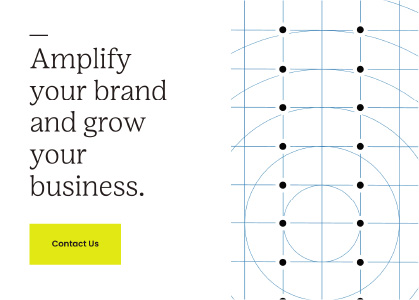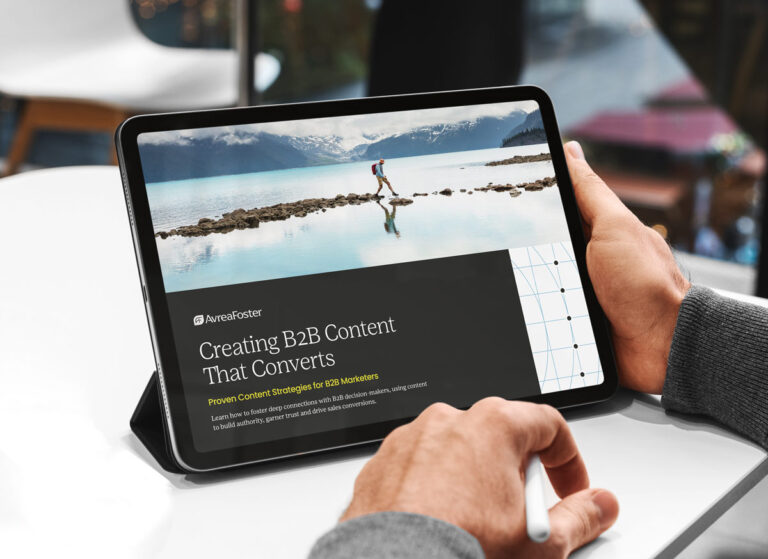- Building a budget roadmap. Discover how to create a marketing budget that aligns with business objectives and effectively prioritizes resources.
- Allocating funds for impact. Learn how to divide your budget across content, media spend and website updates to achieve maximum results.
- Optimizing content investment. Hear insights for repurposing content across multiple formats to maximize ROI, with examples from Brittany and her team.
- Leveraging digital advertising. Get advice for using digital channels and trade show-specific campaigns to reach target audiences.
- Avoiding budget pitfalls. Uncover common budgeting mistakes and learn how to stay adaptable during periods of change.
READ THE TRANSCRIPT
Brittany Feldman:
In a perfect world, we would collaborate on what net new business or other KPIs are critical to your business objectives, and then back into a budget based on what is required to hit those targets.
Announcer:
Welcome to the podcast, B2B Insights, our take on a podcast series where we dive in and discuss all things B2B marketing. B2B Insights is brought to you by AvreaFoster, one of the most respected brand and digital marketing agencies in the Southwest. At AvreaFoster, we build authentic relationships so brands can grow and prosper. Learn more at AvreaFoster.com.
Matthew Petrikin:
Hello everyone. Welcome to the podcast, B2B Insights. I’m Matthew Petrikin, business development, and with us always, co-host, Dave Foster, CEO of AvreaFoster. Today we have Brittany Feldman, our senior director of brand management at AvreaFoster, joining us. Welcome Brittany.
Brittany:
Hi. Good to be here.
Matthew:
Awesome. Well, Dave, I know we’ve got a lot to cover today, an important topic going over marketing budgets. I want to hop right in. You know, we talk a lot about the importance of the marketing budget. Why is it so important for these businesses that we’re working with to have a marketing budget and to establish it?
Brittany:
So think of a marketing budget like a road map that should be used to help you prioritize and guide your marketing efforts and resources effectively. Some of our clients come to us with a set budget in mind. Others just really need our help in navigating all the different things they need to do for the year and have no idea where to start. So in both cases, we always want to make sure these efforts are aligned with business goals and objectives, and we want to be able to tie our successes to organizational growth. That’s the foundation of what we need to establish and accomplish through the year.
Dave Foster:
Can you give us some examples of how business objectives can drive marketing goals and the subsequent budget?
Brittany:
Absolutely. So I have a few examples of ways you can move the needle. One is, if your objective is to increase brand awareness, then you need to focus on tactics like advertising, industry events, website optimization and other brand-related activities. We have some clients that just need awareness for specific target audiences, or they need to start from scratch. Budgets are really going to depend on the level of need but it does not always have to be a huge investment. Sometimes the simplest things, like updating messaging on your website to more effectively speak to your evolved target audiences can make all the difference. I do want to note that this one is the hardest to measure, but I think that’s a podcast for another time. If you want to increase revenue, then you should consider lead generation strategies like content marketing, targeted campaign development and lead nurturing. These often turn into retainer based agreements that help drive predictability for client budgets, because they are ongoing and need to be nurtured throughout the year. I highly recommend considering a monthly retainer amount that you are comfortable with, and then the agency can help you figure out how to make the most of that budget against your goals. If boosting customer retention is the goal, the shift is more to the bottom of the funnel, tactics such as email marketing, organic social and other activities that keep your customers engaged. Really, it’s great to think through all these different objectives and again, help us, help you and your agency can help you think through all the different pieces and parts that you might not be thinking through.
Dave:
Good points, Brittany. So once your business goals and your marketing objectives are truly aligned, then how do you determine that marketing budget from there?
Brittany:
This is definitely one of the most commonly asked questions I get from clients, how much should I spend on marketing? And there’s really a lot of different opinions on how to drive the perfect marketing budget. I think the most common approach, though, involves looking at your company’s revenue and then allocating a percentage of that revenue toward marketing. From there, it’s taking your priorities into consideration and working to see what your team can handle and where you might need to engage outside support. For most companies, this can range anywhere from 5% to 10% of revenue. But in a perfect world, we would collaborate on what net new business or other KPIs are critical to your business objectives, and then back into a budget based on what is required to hit those targets. For example, what investment is required to fill a funnel with qualified leads that end up as sales qualified leads and then a customer. There’s just a lot to figure out there, and all of this needs to be taken into consideration.
Matthew:
Yeah, great point. And so you know, once you have that marketing budget in place, what’s the best way for them to strategically allocate that budget?
Brittany:
Yeah, so this typically falls into a few buckets for consideration. You’ve got content marketing, so that’s budget for blogs, videos, infographics and other content. You got media spend. So this covers online ads, print ads and any other paid media. Then you have your website, so that’s your biggest sales tool, and you need to carve out a budget for ongoing maintenance and optimization, or maybe even updating that site to help make sure that your paid media efforts are being fully optimized. And then you have resource costs like internal personnel and agency fees. There are other marketing tactics to consider, like trade shows, events and sponsorships, customer outreach, like email and direct mail. You’ve got your sales materials, you’ve got your pitch decks, and then you know, if you go a layer deeper, you have costs like market research, training and travel. So all of those need to be factored into your budgets over time.
Matthew:
Yeah, you mentioned something interesting, that content marketing is essential for B2B success. And you know, how should businesses approach budgeting for content creation to ensure that they’re producing impactful content out there?
Brittany:
As we know, content is king and B2B marketing, and it’s really important to allocate sufficient funds for high quality content creation that includes blogs, videos, infographics, guides, white papers and podcasts like this one. We also work with clients to identify what type of content is right for their customer sales journey, and then map out a plan to deliver that content throughout the year. After completing our initial research, we build personas and identify topics that will connect with those personas, and then that becomes our content roadmap. From there, we’re able to price out costs associated with creating that content across all the formats I mentioned, and we typically work in these 90 day sprints. So that gives us enough time to budget content and then spread out budgets throughout the year.
Matthew:
Yeah, and so how can businesses ensure that they get the most value out of their content budget?
Brittany:
To maximize value, businesses should repurpose content across multiple channels. For example, a blog post can be turned into an infographic or a video. Lately, here’s a little story. Kenny, our creative director, has been putting together these really cool content matrices to show clients how to turn one pillar and idea into five to 10 different content pieces. This really has been a game changer in how we have been presenting our content strategies and our clients are really responding to the structure. From there, then we can put everything into a funnel, but starting with that foundation of how it all comes together from one idea is very powerful and honestly just easier to visualize, because you got to start somewhere. And then, of course, once a strategy is launched, we need to consistently measure content performance and adjust strategies based on data to get the most out of your budget. So if you’re seeing that your guides are performing really, really well, but your blogs aren’t, then maybe you need to shift your focus, to focus more on the guides versus, you know, pumping out all these blogs. It just depends on what the market looks like.
Dave:
So let’s shift a little bit from developing that content that we use out in the marketplace to discuss advertising specifically, how should businesses approach their advertising budget?
Brittany:
Yeah, so since most B2B sales journeys occur online, today’s advertising options always should involve digital channels like paid search, social media advertising and display ads. We also have some clients that are very active in trade shows, so we work with them to craft geo-targeted campaigns around specific events, trying to get people to the booth or promoting something that’s going on at your booth. This has been very successful, and we’ve seen an increase in traffic from there. Also, when it comes to recommending advertising budgets for our clients, it’s really a collaborative process that involves looking at customer base, finding where those customers are online, and then building a tailored omni-channel strategy to reach them with the right message at the right time. You know your clients best, and we always love to take your information and mix it with our research to come up with a really solid plan. And then the benefit of digital advertising is that we can track performance after 30, 60, 90 days to identify which channels perform best and then scale up accordingly. We usually don’t, you know, recommend going in with your full budget if you’re starting from scratch. It’s about finding that balance and then growing from there.
Dave:
So are there any common mistakes that businesses make when planning their marketing budgets?
Brittany:
A common mistake is not planning for the unknown. Marketing is dynamic. Things in your business change, and so it’s really important to leave room for unexpected opportunities or shifts in strategies. For instance, we have been working on a website redo for a large manufacturing company, and literally, the week we were supposed to launch, there was a shift in its services strategy that impacted the navigation and content on one specific part of the website. Luckily, our client was very understanding about the importance of investing time to address this swiftly and keep the project on track, so that we didn’t launch it too far from the original date. So we had to shift some of our retainer priorities, but he was very flexible and allowed us not to lose focus on the main task at hand. It’s those types of collaborations and shifts in strategy that you really kind of got to watch out for. And being flexible to, you know, push something aside to get, you know, your priority done. And that can be hard when you have a lot of people coming at you for different things, but we appreciate when clients are able to be flexible in that way. Also understanding the cost of content creation or technology can lead to budget shortfalls. So when it comes to big content marketing strategies, we most often partner with our clients on these efforts to help bring down the outside costs.
So, we’ve done everything from just doing the research and writing an outline and then passing that over to our client to write, and then we’ll kind of help consult throughout the process, or, you know, we’ll just take their content and we’ll just make it look really beautiful and help match, you know, the ads that are going into market, because a lot of times, clients have great content, it just looks a little bit outdated, and they come to us to help them elevate it and give it life. So think about ways that you can partner with your agency to bring your plan together and help your team do what they do best. Last on this list is just not planning for the long term needs beyond the current year. So often projects for a new year launch need to start the year prior. So always remember that when planning out for the year because that definitely comes up a lot.
Matthew:
Yeah, and you know, looking ahead, how do you see marketing budgets evolving over the next year or two? It’s got to be an interesting forecast for the next couple years.
Brittany:
Yeah, there is a lot of shift in the way people are planning, and I think budgets are likely going to shift towards more digital channels with a focus on personalization and data-driven decisions. You know, at AvreaFoster we are really into personas. We want to make sure we’re talking to the right targeted audiences, and the more we can personalize our strategies, the more effective your campaigns are going to be. Companies will also start investing in automation and AI to optimize their spend and improve ROI. At AvreaFoster, we are experimenting with our own marketing tactics and seeing how to make the most out of our budget with the latest and greatest tools out there, which in turn is helping us make more confident recommendations to our clients about the future of their marketing spend. And we also appreciate clients that let us experiment with that as well, because there’s a lot of unknown, you know, AI tools out there. And I think working together with clients and agencies is going to be a great way to figure out how these tools are going to take us into the future. There’s just a lot of exciting innovation out there, and we’ve seen many of our clients excited to jump in on this new marketing journey, and I’m just excited to see where it takes us.
Matthew:
Yeah, I think there’s a lot of new in the marketing world, and it’s definitely exciting where, where it’s going to go, an ever-evolving change in our landscape.
Dave:
Yeah, so these are great insights. Brittany, thank you for sharing those with us, and we hope that our listeners can take some of this and move forward and answer the elusive question, how to build a marketing budget. Thank you.
Brittany:
Thank you.
Announcer:
This has been B2B insights. Find all our news and sign up to receive our e-newsletter at AvreaFoster.com/contact. B2B Insights is provided by AvreaFoster. Copyright 2024 AvreaFoster, Inc. All rights reserved. Digital redistribution to the public is permitted only with express written permission from AvreaFoster, Inc. Visit avreafoster.com for more information.
Dig Deeper
* Required field



